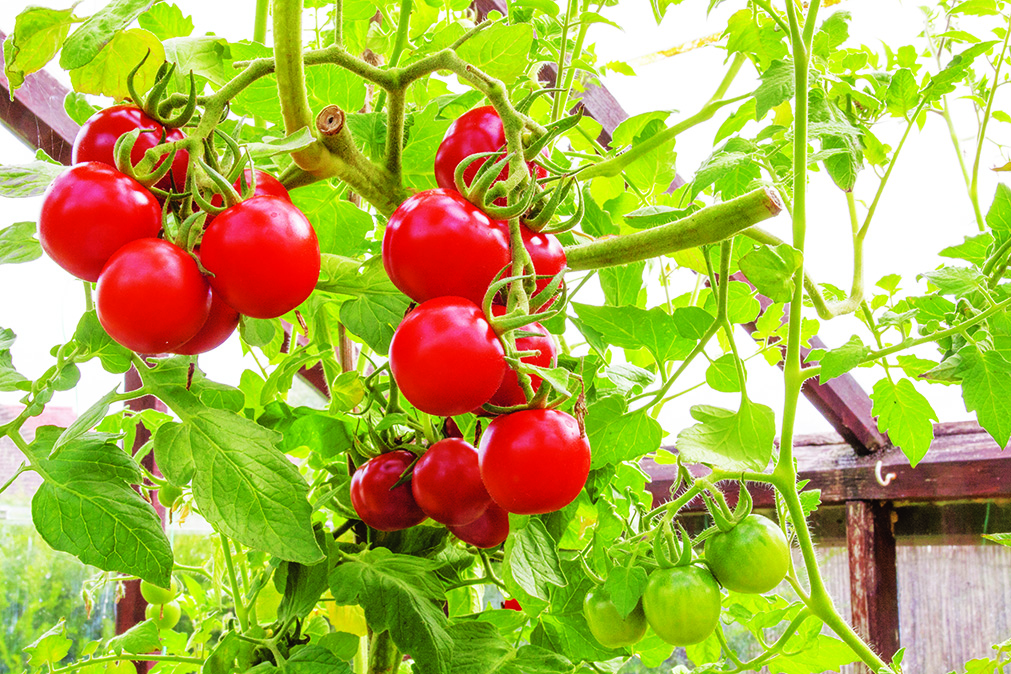Why are my tomato leaves turning yellow?
Wondering why tomato leaves are turning yellow? Get the lowdown and keep plants healthy


If you’ve seen tomato leaves turning yellow, you’ll be anxious to know why – and what you can do about it.
Growing tomatoes yourself is well worthwhile because the taste of a homegrown tomato is far superior to a store-bought version, so seeing the leaves of your carefully tended plants turn yellow can be alarming.
There are actually a few reasons that mean your kitchen garden ideas can be compromised by tomato leaves turning yellow, and our guide has all the details you need to identify the problem and solve it.
Why are my tomato leaves turning yellow?
The good news about tomato leaves turning yellow is that many of the problems that cause the color change can be remedied.
Be mindful that, as a rule, yellowing leaves should be removed when pruning tomato plants, and discover the details about why leaves go yellow below.
Tomato leaves turning yellow due to watering issues
Issues with watering can cause tomato leaves to turn yellow – and both under and overwatering could be the cause.
Soil that is too wet suffocates the roots, which rot, and the plant misses out on both water and nutrients (more on the latter below).
Design expertise in your inbox – from inspiring decorating ideas and beautiful celebrity homes to practical gardening advice and shopping round-ups.
‘Overwatering is one of the most common causes of yellowing tomato leaves,’ says professional gardener Matt Eddleston, founder of Gardening Vibe. ‘Look for signs of the plant wilting, bumps on the lower leaves, and cracked fruit as confirmatory signals.
‘The most obvious way to solve this problem is to reduce the amount and frequency of your watering. A deep watering twice a week is better than daily watering. Check the top 1 to 2in (2.5 to 5cm) of soil and when it feels dry, water them again. And if the overwatered plant is in a pot, move it into the sun to allow the soil to dry quicker.
‘Make sure the soil drains well enough. You can add amendments such as perlite and coarse grain sand if the potting soil is holding too much water. And check that the pot has adequate drainage holes.’
If underwatering is the problem instead, tomato leaves will likely wilt first then turn yellow.
Tomato leaves turning yellow because of soil compaction
Soil compaction is another reason tomato leaves turn yellow. ‘Having compact soil around your tomato will suffocate it and it will go yellow from the bottom up,’ says Silvia Borges, owner of EnviroMom. Loosen the soil around the plant, she recommends.
Be aware, though, that it is possible to damage the roots with this remedial action, so prepare soil well before planting tomatoes to swerve the issue further down the road.
Tomato leaves turning yellow from lack of nutrients
Tomato leaves could turn yellow because the plant is short on nutrients, including nitrogen, iron and magnesium.
Tomatoes should be fed regularly using a tomato fertilizer to avoid nitrogen deficiency that can cause leaves to turn yellow, and which you’ll see happening to older leaves first.
A lack of iron also cause yellowing, especially in younger leaves, while magnesium deficiency can result in yellow areas between the veins on older leaves.
Tomato leaves turning yellow due to diseases
Another reason why your tomato leaves are turning yellow is disease. ‘Fungal and viral diseases are common explanations for yellow tomato leaves,’ explains Matt Eddleston. ‘Early blight is a fungal disease that usually appears after the plant starts to produce fruit and causes brown, circular spots with the surrounding leaf turning yellow.’ Late tomato blight can also turn leaves musty yellow, and tomato blight treatments should be carried out.
‘Some locations are more susceptible to fungal disease because of heat and humidity,’ continues Matt. ‘If you find yourself having a problem with fungal diseases, you can spray your plants with an organic fungicide.
‘A common viral disease that causes leaf yellowing is the tomato yellow leaf curl virus. The margins of the leaves turn yellow, starting with the newer leaves. The leaves curl over at the edges and often have stunted growth. The virus is spread between plants by the silverleaf whitefly. Infected plants have to be removed and carefully disposed of.’
Tomato leaves turning yellow because of transplant shock
Recently transplanted tomato seedlings can end up with yellow leaves because of transplant shock. To avoid it, when you’re considering when to plant tomatoes, build in the time to harden them off by putting them outside during the day and bringing them in at night over the course of two to three weeks.
However, if they do end up with yellow leaves after transplanting, don’t worry too much. ‘If the plant is healthy, this is usually just a period of adjustment, and the problem should resolve itself,’ says Matt Eddleston.
Tomato leaves turning yellow because they’re seed leaves
There are some yellowing tomato leaves you don’t need to be concerned about. ‘Tomato plants have two sets of leaves – regular and seed leaves, also called cotyledons,’ explains Silvia Borges.
‘They are usually small leaves, only living until the plant starts growing and developing. It’s like a nutrition bank designed to boost the plant up until it can stand on its two feet. Afterward, they turn yellow and die out. Cotyledons grow in the lower part of the stem, near the ground, and are the easiest to spot.’

Sarah is a freelance journalist and editor. Previously executive editor of Ideal Home, she’s specialized in interiors, property and gardens for over 20 years, and covers interior design, house design, gardens, and cleaning and organizing a home for Homes & Gardens. She’s written for websites, including Houzz, Channel 4’s flagship website, 4Homes, and Future’s T3; national newspapers, including The Guardian; and magazines including Future’s Country Homes & Interiors, Homebuilding & Renovating, Period Living, and Style at Home, as well as House Beautiful, Good Homes, Grand Designs, Homes & Antiques, LandLove and The English Home among others. It’s no big surprise that she likes to put what she writes about into practice, and is a serial house renovator.